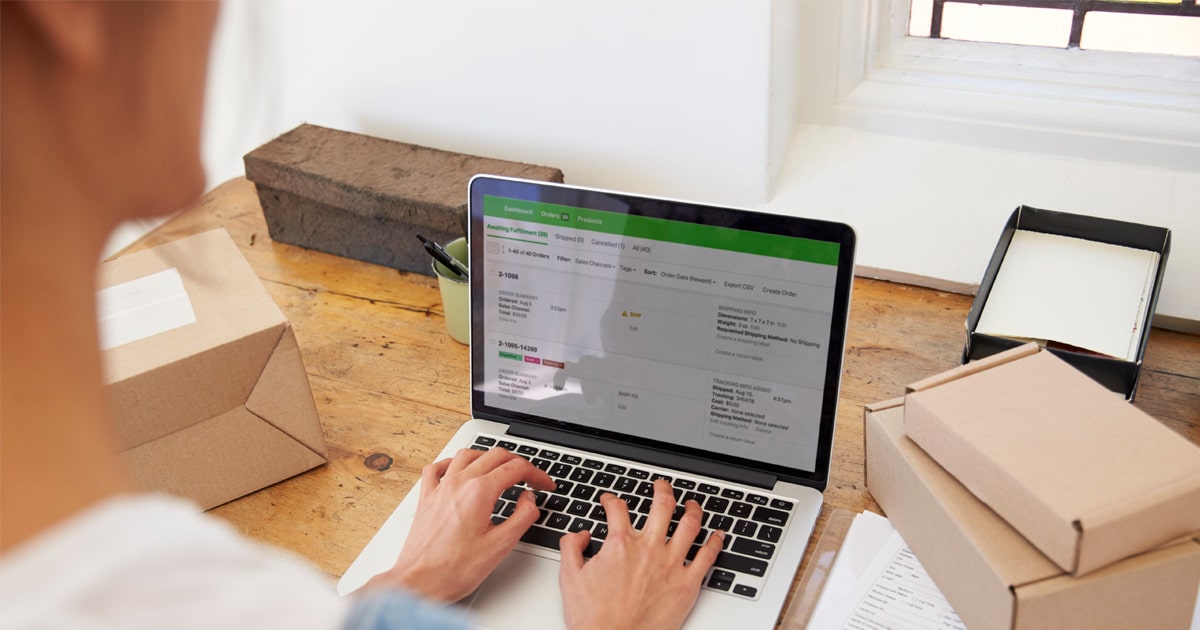Your Shopify store is thriving. Orders are flowing in from customers across Europe, the UK, and beyond. Then you get that sinking feeling – have you been charging VAT correctly? Are you registered where you need to be? What about those Amazon FBA warehouses storing your products in Germany?
Ecommerce VAT rules can make or break your business. Get them wrong and you’re facing penalties, frozen funds, and hours of expensive remedial work. Get them right and VAT becomes a manageable part of your operations rather than a constant source of stress.
The rules changed dramatically in July 2021 with the EU’s VAT e-Commerce Package. Brexit added another layer of complexity for Irish businesses selling to UK customers. And if you’re using Amazon FBA or TikTok Shops, you’ve got additional registration obligations that many sellers don’t realise until it’s too late.
This isn’t about becoming a VAT expert overnight. It’s about understanding the key rules that affect your business and knowing when to seek professional help.

What Is VAT And Why Does It Matter For Ecommerce Businesses?
Value Added Tax (VAT) is a consumption tax charged on most goods and services sold within the EU. For ecommerce businesses, VAT affects every aspect of your operations, from pricing strategies to cash flow management.
Ireland operates three main VAT rates:
- Standard rate (23%) – Most goods and services
- Reduced rate (13.5%) – Certain goods like fuel, building services
- Second reduced rate (9%) – Tourism, sporting facilities, hairdressing
EU VAT for ecommerce works differently than traditional retail VAT. When you sell online, the customer’s location often determines which country’s VAT applies, not where your business is based. This principle affects Irish businesses selling across Europe and creates obligations you might not expect.
B2C vs B2B: Different Rules Apply
Business-to-consumer (B2C) sales generally require VAT charged at the customer’s local rate. If you’re selling to a consumer in France, you’ll likely need to charge French VAT, not Irish VAT.
Business-to-business (B2B) sales work differently. When selling to VAT-registered businesses in other EU countries, you can often zero-rate the sale and let the customer account for VAT through reverse charge mechanisms.
The key difference lies in having valid VAT numbers. B2B customers should provide their VAT registration number, which you must verify through the EU’s VIES system.
Place Of Supply Rules: Where Is Your Sale Taxed?
Place of supply rules determine which country’s VAT applies to your sales. These rules are fundamental to ecommerce VAT rules compliance and affect every online transaction.
For Physical Goods
The place of supply for goods is typically where the goods are located when the supply takes place. If you’re shipping from Ireland to a customer in Germany, the place of supply depends on several factors:
- Distance selling thresholds – Each EU country sets thresholds (typically €10,000) below which you charge your home country’s VAT
- Storage locations – If you store goods in German warehouses, German VAT may apply from the first sale
- Fulfilment arrangements – Amazon FBA creates different obligations than shipping directly from Ireland
For Digital Services and SaaS
Digital services follow different rules. The place of supply is usually where the customer is located, regardless of where your business operates. This affects SaaS companies and marketing agencies selling digital services across Europe.
You determine customer location through:
- Billing address
- IP address
- Bank account location
- Country code of SIM card (for mobile services)
At least two pieces of non-contradictory evidence are required to establish customer location reliably.
Selling To Ireland: What Ecommerce Sellers Need To Know
VAT registration for ecommerce sellers in Ireland depends on your annual turnover and business activities. Understanding these thresholds helps you plan for registration obligations and cash flow impacts.
Irish VAT Registration Thresholds
- Goods: €85,000 annual turnover
- Services: €42,500 annual turnover
- Distance sales to Ireland from other EU countries: €10,000
Voluntary Registration Benefits
Many ecommerce businesses benefit from voluntary VAT registration even below the thresholds:
- Input VAT recovery – Claim back VAT on business purchases and expenses
- Professional credibility – VAT numbers signal established business status
- B2B sales advantages – Zero-rate sales to other EU businesses
- Amazon seller requirements – Some marketplaces prefer VAT-registered sellers
Registration Process and Requirements
Irish VAT registration through Revenue requires:
- Completed TR1 form
- Proof of business address
- Bank account details
- Business registration documents
- Projected turnover figures
Irish VAT numbers follow the format: IE[7 digits][1-2 letters] or IE[digit][letter][6 digits][letter].
The registration process generally takes 2-3 weeks, but planning ahead prevents delays that could affect your ability to trade legally.
Selling To The EU: One Stop Shop (OSS) VAT Scheme
The One Stop Shop (OSS) system revolutionised EU VAT for ecommerce by allowing businesses to report and pay VAT for all EU countries through a single portal. This system applies to B2C sales across the EU and significantly reduces administrative burden.
How OSS Works
Instead of registering for VAT in every EU country where you have customers, you can register for OSS in one country (usually where your business is established) and report all EU sales through a single quarterly return.
OSS covers:
- Distance sales of goods to consumers in other EU countries
- Digital services to consumers across the EU
- Sales below €10,000 in each destination country per calendar year
Union OSS vs Non-Union OSS
Union OSS is for businesses established in the EU (including Ireland). You register in your home country and report sales to all other EU countries.
Non-Union OSS serves businesses established outside the EU but selling to EU consumers. These businesses can register in any EU member state.
Practical OSS Implementation
When you register for OSS, you’ll:
- Charge local VAT rates – Apply the destination country’s VAT rate to each sale
- File quarterly returns – Submit a single return covering all EU sales
- Make single payments – Pay all VAT due through your OSS registration country
- Maintain detailed records – Keep evidence of customer location and VAT calculations
The system automatically distributes collected VAT to the appropriate member states, eliminating the need for multiple registrations and returns.

Selling To The UK Post-Brexit: VAT Rules Explained
Brexit fundamentally altered VAT obligations for Irish ecommerce businesses selling to UK customers. The UK is no longer part of EU VAT systems, creating new registration and compliance requirements.
UK VAT Registration Requirements
Irish businesses must register for UK VAT if:
- Annual sales to UK consumers exceed £85,000
- You store goods in UK warehouses
- You use UK fulfilment services
Distance Selling to the UK
Sales to UK consumers are now treated as exports from Ireland and imports into the UK. This creates several implications:
- Irish VAT – Typically zero-rated as exports
- UK VAT – Applied upon import, either by you or the customer
- Customs declarations – Required for all shipments
- Duty obligations – May apply depending on product type and value
Managing UK Compliance
Many Irish ecommerce businesses find UK post-Brexit compliance challenging. Options include:
- Register directly – Complete UK VAT registration and handle obligations internally
- Use UK fulfilment partners – Let established UK partners handle VAT obligations
- Marketplace facilitation – Platforms like Amazon UK may handle VAT collection
- Focus on EU markets – Some businesses choose to exit the UK market due to complexity
Selling To The Rest Of The World (ROW)
When selling outside the EU and UK, VAT treatment becomes more straightforward for Irish businesses, but other tax obligations may arise.
Export VAT Treatment
Sales to customers outside the EU are generally zero-rated for Irish VAT purposes, provided you have adequate evidence of export:
- Shipping documentation
- Customs declarations
- Proof of delivery outside the EU
Customer Tax Obligations
Your customers may face:
- Import VAT – Charged by their local customs authorities
- Customs duties – Depending on product classification and value
- Local sales taxes – Some countries impose additional taxes
Managing Customer Expectations
Clear communication about potential additional charges helps maintain customer satisfaction:
- Include duty and tax disclaimers in checkout processes
- Provide landed cost calculators where possible
- Offer duty-paid delivery options through international carriers
Understanding these obligations helps you price competitively while avoiding customer complaints about unexpected charges.
Amazon FBA & TikTok Shops: VAT Where The Product Is Fulfilled From
Using third-party fulfilment services like Amazon FBA or TikTok Shops creates specific VAT obligations based on where your products are stored and fulfilled.
Amazon FBA VAT Implications
When you use Amazon FBA, your VAT obligations depend on warehouse locations:
- Irish FBA warehouses – Irish VAT applies to sales within Ireland
- German FBA warehouses – German VAT registration required for sales from German stock
- Pan-EU FBA – Potential VAT registrations needed in multiple countries
Amazon’s inventory placement service can move your products between warehouses automatically, potentially creating unexpected VAT obligations in new countries.
TikTok Shop Compliance
TikTok Shops operate similarly to Amazon FBA but with additional considerations:
- Marketplace facilitator rules – TikTok may collect VAT on your behalf in some countries
- Influencer collaborations – Additional compliance considerations for promotional activities
- Cross-border logistics – Understanding where stock is held and fulfilled from
Managing Multi-Country Fulfilment
Successful management requires:
- Clear stock allocation policies – Control where your inventory is stored
- Regular compliance reviews – Monitor which countries you’re selling from
- Professional advice – Complex multi-country VAT requires specialist expertise
Our ‘How To Manage Remote Teams For Your E-Commerce Business’ guide provides additional insights on managing operations across multiple jurisdictions.
IOSS & Drop Shipping From Outside The EU
The Import One Stop Shop (IOSS) scheme simplifies VAT collection for goods imported into the EU with values up to €150, excluding excise goods.
How IOSS Works
IOSS allows online platforms and sellers to collect and remit EU VAT at the point of sale rather than at importation. This creates a smoother customer experience and reduces customs delays.
Benefits include:
- No import VAT at customs – Customers receive goods without additional VAT charges
- Faster customs clearance – Reduced processing times at borders
- Single VAT registration – Cover all EU imports through one registration
Drop Shipping Applications
IOSS particularly benefits drop shipping models where:
- Products ship directly from non-EU suppliers to EU customers
- Order values remain below €150
- Multiple small shipments replace large bulk imports
IOSS Registration and Compliance
IOSS registration requires:
- EU establishment – Either direct business presence or appointed intermediary
- Monthly returns – Report all IOSS sales and remit collected VAT
- Detailed records – Maintain evidence of imports and VAT collected
Common VAT Pitfalls For Ecommerce Sellers
Understanding frequent VAT errors helps you avoid expensive penalties and compliance issues.
Registration Timing Errors
Many businesses discover VAT registration obligations too late:
- Threshold monitoring – Track sales by destination country monthly
- Storage obligations – Register before storing goods in new countries
- Marketplace requirements – Some platforms require VAT registration regardless of thresholds
Incorrect VAT Rate Application
Using wrong VAT rates creates compliance issues and customer complaints:
- Product classification – Make sure you understand how your products are classified for VAT
- Customer location – Verify customer locations accurately
- Rate changes – Monitor VAT rate changes in destination countries
Poor Record Keeping
Inadequate records make VAT compliance difficult and expensive:
- Transaction details – Maintain complete records of all sales
- Customer information – Keep evidence of customer locations and VAT number validations
- Integration challenges – Make sure your accounting software captures all necessary VAT data
Software Integration Issues
Many VAT problems stem from poor integration between sales platforms and accounting systems. Our ecommerce growth guide provides detailed guidance on setting up proper VAT recording and reporting systems.
Technology Solutions For VAT Compliance
Modern ecommerce businesses need integrated technology solutions to manage VAT compliance efficiently.
Accounting Software Integration
Leading accounting platforms offer VAT-specific features:
- Xero – Comprehensive EU VAT reporting and OSS support
- QuickBooks – Multi-country VAT handling and automatic rate updates
- Sage – Advanced VAT compliance features for complex businesses
Automated VAT Calculation
Real-time VAT calculation services integrate with ecommerce platforms to:
- Apply correct VAT rates based on customer location
- Handle rate changes automatically
- Provide audit trails for compliance purposes
Compliance Monitoring
Regular compliance reviews should cover:
- Registration threshold monitoring – Track approaching thresholds in all relevant countries
- Rate accuracy checks – Verify VAT rates applied match current regulations
- Filing deadline management – Make sure timely submission of all required returns
Planning Your VAT Strategy
Successful ecommerce VAT management requires strategic planning rather than reactive compliance.
Market Entry Planning
Before entering new markets, consider:
- Registration requirements – Understand when VAT registration becomes mandatory
- Compliance costs – Factor ongoing VAT obligations into pricing and margins
- Technology requirements – Make sure your systems can handle new country requirements
Cash Flow Management
VAT significantly impacts cash flow:
- Collection timing – VAT is due when invoices are issued, not when paid
- Payment schedules – Different countries have different VAT payment deadlines
- Input VAT recovery – Plan for VAT refunds on business purchases
Professional Support
Complex VAT situations benefit from professional expertise:
- Registration guidance – Ensure correct and timely registrations
- Ongoing compliance – Regular reviews prevent problems from developing
- Strategic advice – Optimise VAT positions as your business grows
Staying Compliant As Regulations Evolve
VAT regulations continue evolving as governments adapt to digital commerce realities.
Monitoring Regulatory Changes
Stay informed about:
- Threshold adjustments – Countries periodically review registration thresholds
- New schemes – Additional simplification measures may become available
- Digital tax developments – Broader digital taxation beyond VAT
Quarterly Compliance Reviews
Regular reviews should assess:
- Current registrations – Make sure all necessary registrations remain active
- Threshold positions – Monitor approaching registration requirements
- Rate accuracy – Verify VAT rates match current regulations
Professional Development
VAT knowledge requirements continue expanding. Consider:
- Training programmes – Keep internal teams updated on VAT developments
- Professional networks – Connect with other ecommerce businesses facing similar challenges
- Expert relationships – Maintain relationships with VAT specialists
Taking Action: Your Next Steps
VAT compliance doesn’t need to be overwhelming when approached systematically.
Immediate Actions
Start with these priorities:
- Audit current registrations – Verify you’re registered where required
- Review VAT rates – Make sure your systems apply correct rates
- Check thresholds – Monitor sales by destination country
- Validate processes – Confirm customer location determination methods
Medium-Term Planning
Over the next 3-6 months:
- System integration – Connect sales platforms with accounting software
- Process documentation – Create clear VAT procedures for your team
- Compliance calendar – Schedule regular VAT reviews and filings
Long-Term Strategy
Plan for sustainable growth:
- Technology investment – Build systems that scale with your business
- Professional relationships – Establish connections with VAT specialists
- Market expansion – Understand VAT implications before entering new territories
Your Path To VAT Confidence
VAT compliance is a critical foundation for ecommerce success. The businesses that master these rules gain competitive advantages through accurate pricing, efficient operations, and confident market expansion.
If you’re ready to get your VAT compliance sorted properly, we’re here to help. Contact us to discuss your specific situation and learn how proper VAT management can support your business goals.
Your ecommerce business deserves VAT processes that work as hard as you do.
FAQs
What are the main ecommerce VAT rules I need to know as an Irish business?
The key ecommerce VAT rules include understanding place of supply (where your sale is taxed), VAT registration thresholds in each country you sell to, the One Stop Shop system for EU sales, and special obligations when using services like Amazon FBA. You must also comply with post-Brexit UK rules if selling to British customers.
When do I need to register for VAT in other EU countries?
VAT registration for ecommerce sellers in other EU countries is typically required when you exceed distance selling thresholds (usually €10,000 per country per year) or when you store goods in that country. The One Stop Shop scheme can eliminate the need for multiple registrations for B2C sales below certain thresholds.
How does the EU One Stop Shop (OSS) work for ecommerce businesses?
OSS allows you to register for EU VAT for ecommerce in one country and report sales to consumers in all other EU countries through a single quarterly return. You charge the destination country’s VAT rate but file and pay through your OSS registration country, which then distributes the VAT to appropriate member states.
What VAT obligations do I have when using Amazon FBA?
Amazon FBA creates VAT obligations based on where your products are stored. If Amazon stores your products in German warehouses, you typically need German VAT registration regardless of sales volumes. This applies to each country where Amazon stores your inventory.
How has Brexit affected VAT for Irish businesses selling to the UK?
Post-Brexit, UK sales are treated as exports from Ireland (typically zero-rated) and imports into the UK. Irish businesses may need UK VAT registration if sales exceed £85,000 annually or if they store goods in the UK. Customs declarations are now required for all shipments.
What is IOSS and how does it help with drop shipping?
IOSS (Import One Stop Shop) allows collection of EU VAT at the point of sale for goods imported from outside the EU worth up to €150. This eliminates import VAT charges at customs, speeding up delivery and improving customer experience, particularly beneficial for drop shipping models.
What are the most common VAT mistakes ecommerce businesses make?
Common mistakes include failing to register when storing goods abroad, applying incorrect VAT rates based on customer location, poor record keeping for compliance purposes, and not monitoring distance selling thresholds. Many businesses also struggle with proper integration between sales platforms and accounting systems.
How do I determine the correct VAT rate for international sales?
VAT rates depend on customer location and product type. For B2C sales, you typically charge the destination country’s VAT rate. You determine customer location using at least two pieces of non-contradictory evidence such as billing address, IP address, or bank location. B2B sales to VAT-registered businesses can often be zero-rated using reverse charge mechanisms.



